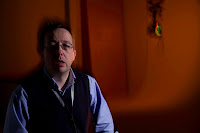Firstly, we went through the studio basics, such as health and safety. But I'm going to attempt to repeat everything Dave told me to make sure I've understood how everything works. Firstly, a light actually has two lights: the modelling light and the flash bulb. The flash is actually what 'goes off' when the camera clicks. The lower the setting, the shorter the time the flash goes off - good for 'freezing' action. The higher it is, the longer the flash will be on.
If your camera is set to a shutter speed of higher that 1/200, you'll get black bars on the image so it's best to set your camera to 1/125 and then meter from there. However, it's actually the aperture that controls flash – shutter speed controls the ambient lighting.
The lights are set at increments that range from 0.5 to 6.0 and can be adjusted in 0.1 increments. 10 increments equals one f/stop on the camera, so if you meter and it comes up with f/11 and 6 bars, you would turn the light down by 1.6 to give a perfect reading of f/8 and 1/125 shutter speed.
Using one light, Dave very kindly modelled for me:
 |
| 1 studio light to the photographer's right |
 |
| 1 black polyboard |
 |
| 1 black polyboard, 1 white polyboard |
But you can also turn the flash up one full stop (e.g 10 increments) higher than the flash light in front. Dave says this is good for bleaching and can bleach out blemishes such as crinkles in paper, or foot marks:
You can also just whack the lights up, but this comes out so overbleached you lose the lines/edges of the picture:
I also asked Dave about night photography, and he set up a practical example in the studio.
In this picture, the flash freezes the model in the foreground and completely obliterates the background, due to faster shutter speed. This is a good example of how shutter speed controls ambient lighting.
However, even with longer exposure times on a tripod, this 'flashing' then captures ambient light in the background without over-exposing the subject in the foreground.
All I can do now is employ what I learned in the studio, so wish me luck for the next time I go in!






No comments:
Post a Comment